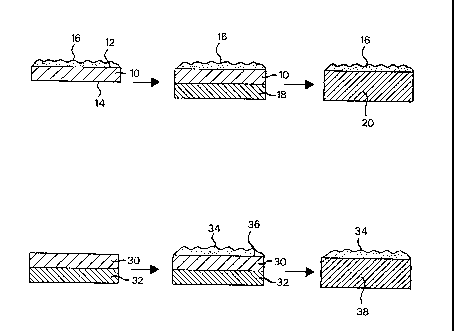Une partie des informations de ce site Web a été fournie par des sources externes. Le gouvernement du Canada n'assume aucune responsabilité concernant la précision, l'actualité ou la fiabilité des informations fournies par les sources externes. Les utilisateurs qui désirent employer cette information devraient consulter directement la source des informations. Le contenu fourni par les sources externes n'est pas assujetti aux exigences sur les langues officielles, la protection des renseignements personnels et l'accessibilité.
L'apparition de différences dans le texte et l'image des Revendications et de l'Abrégé dépend du moment auquel le document est publié. Les textes des Revendications et de l'Abrégé sont affichés :
| (12) Demande de brevet: | (11) CA 2070750 |
|---|---|
| (54) Titre français: | ELEMENTS D'OUTILS |
| (54) Titre anglais: | TOOL COMPONENTS |
| Statut: | Réputée abandonnée et au-delà du délai pour le rétablissement - en attente de la réponse à l’avis de communication rejetée |
| (51) Classification internationale des brevets (CIB): |
|
|---|---|
| (72) Inventeurs : |
|
| (73) Titulaires : |
|
| (71) Demandeurs : |
|
| (74) Agent: | GOWLING WLG (CANADA) LLP |
| (74) Co-agent: | |
| (45) Délivré: | |
| (22) Date de dépôt: | 1992-06-09 |
| (41) Mise à la disponibilité du public: | 1992-12-11 |
| Licence disponible: | S.O. |
| Cédé au domaine public: | S.O. |
| (25) Langue des documents déposés: | Anglais |
| Traité de coopération en matière de brevets (PCT): | Non |
|---|
| (30) Données de priorité de la demande: | ||||||
|---|---|---|---|---|---|---|
|
ABSTRACT
A method is provided for producing a tool component which comprises a
CVD diamond layer bonded to a cemented carbide substrate. The method
includes the steps of providing a mass of carbide particles bounded into a
layer with an organic binder, removing the organic binder to produce a
porous mass of the particles, depositing a layer of diamond by CVD on a
surface of the porous mass, placing the porous mass in contact with a layer
of binder metal particles bonded with an organic binder, and heating the
product to allow the metal binder particles to melt and infiltrate the
carbide particles and produce a cemented carbide substrate for the CVD
diamond layer.
Note : Les revendications sont présentées dans la langue officielle dans laquelle elles ont été soumises.
Note : Les descriptions sont présentées dans la langue officielle dans laquelle elles ont été soumises.

2024-08-01 : Dans le cadre de la transition vers les Brevets de nouvelle génération (BNG), la base de données sur les brevets canadiens (BDBC) contient désormais un Historique d'événement plus détaillé, qui reproduit le Journal des événements de notre nouvelle solution interne.
Veuillez noter que les événements débutant par « Inactive : » se réfèrent à des événements qui ne sont plus utilisés dans notre nouvelle solution interne.
Pour une meilleure compréhension de l'état de la demande ou brevet qui figure sur cette page, la rubrique Mise en garde , et les descriptions de Brevet , Historique d'événement , Taxes périodiques et Historique des paiements devraient être consultées.
| Description | Date |
|---|---|
| Inactive : CIB expirée | 2023-01-01 |
| Inactive : CIB de MCD | 2006-03-11 |
| Inactive : CIB de MCD | 2006-03-11 |
| Demande non rétablie avant l'échéance | 2000-06-09 |
| Le délai pour l'annulation est expiré | 2000-06-09 |
| Inactive : Abandon.-RE+surtaxe impayées-Corr envoyée | 1999-06-09 |
| Réputée abandonnée - omission de répondre à un avis sur les taxes pour le maintien en état | 1999-06-09 |
| Demande publiée (accessible au public) | 1992-12-11 |
| Date d'abandonnement | Raison | Date de rétablissement |
|---|---|---|
| 1999-06-09 |
Le dernier paiement a été reçu le 1998-04-03
Avis : Si le paiement en totalité n'a pas été reçu au plus tard à la date indiquée, une taxe supplémentaire peut être imposée, soit une des taxes suivantes :
Les taxes sur les brevets sont ajustées au 1er janvier de chaque année. Les montants ci-dessus sont les montants actuels s'ils sont reçus au plus tard le 31 décembre de l'année en cours.
Veuillez vous référer à la page web des
taxes sur les brevets
de l'OPIC pour voir tous les montants actuels des taxes.
| Type de taxes | Anniversaire | Échéance | Date payée |
|---|---|---|---|
| TM (demande, 6e anniv.) - générale | 06 | 1998-06-09 | 1998-04-03 |
Les titulaires actuels et antérieures au dossier sont affichés en ordre alphabétique.
| Titulaires actuels au dossier |
|---|
| DE BEERS INDUSTRIAL DIAMOND DIVISION (PROPRIETARY) |
| Titulaires antérieures au dossier |
|---|
| BARBARA L. JONES |
| TIMOTHY J. VALENTINE |